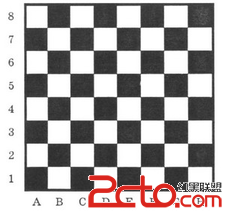點擊打開鏈接 A. Shortest path of the king time limit per test 1 second memory limit per test 64 megabytes input standard input output standard output
The king is left alone on the chessboard. In spite of this loneliness, he doesn't lose heart, because he has business of national importance. For example, he has to pay an official visit to square t. As the king is not in habit of wasting his time, he wants to get from his current position s to square t in the least number of moves. Help him to do this.

In one move the king can get to the square that has a common side Z喎?http://www.Bkjia.com/kf/ware/vc/" target="_blank" class="keylink">vciBhIGNvbW1vbiB2ZXJ0ZXggd2l0aCB0aGUgc3F1YXJlIHRoZSBraW5nIGlzIGN1cnJlbnRseSBpbiAoZ2VuZXJhbGx5IHRoZXJlIGFyZSA4IGRpZmZlcmVudCBzcXVhcmVzIGhlIGNhbiBtb3ZlIHRvKS48L3A+CgoKCklucHV0CjxwPgpUaGUgZmlyc3QgbGluZSBjb250YWlucyB0aGUgY2hlc3Nib2FyZCBjb29yZGluYXRlcyBvZiBzcXVhcmUgPGVtPnM8L2VtPiwgdGhlIHNlY29uZCBsaW5lIKGqIG9mIHNxdWFyZSA8ZW0+dDwvZW0+LjwvcD4KPHA+CkNoZXNzYm9hcmQgY29vcmRpbmF0ZXMgY29uc2lzdCBvZiB0d28gY2hhcmFjdGVycywgdGhlIGZpcnN0IG9uZSBpcyBhIGxvd2VyY2FzZSBMYXRpbiBsZXR0ZXIgKGZyb20gYSB0byBoKSwKIHRoZSBzZWNvbmQgb25lIGlzIGEgZGlnaXQgZnJvbSAxIHRvIDguPC9wPgoKCgpPdXRwdXQKPHA+CkluIHRoZSBmaXJzdCBsaW5lIHByaW50IDxlbT5uPC9lbT4goaogbWluaW11bSBudW1iZXIgb2YgdGhlIGtpbmc="s moves. Then in n lines print the moves themselves. Each move is described with one of the 8: L, R, U, D, LU, LD, RU or RD.
L, R, U, D stand respectively for moves left, right, up and down (according to the picture), and 2-letter combinations stand for diagonal moves. If the answer is not unique, print any of them.
Sample test(s) inputa8 h1output
7 RD RD RD RD RD RD RD
//30 ms 0 KB #include#include #include #include #define M 10 using namespace std; int dir[8][2]= {{0,1},{0,-1},{1,0},{1,-1},{1,1},{-1,0},{-1,1},{-1,-1}}; int g[M][M]; int s_x,s_y,e_x,e_y; bool vis[M][M]; struct sa { int x,y,step; } path[30],p[9][9]; void bfs() { sa pre; queue q; pre.x=s_x; pre.y=s_y; pre.step=0; q.push(pre); vis[s_x][s_y]=1; while(!q.empty()) { sa now=q.front(),next; q.pop(); if(now.x==e_x&&now.y==e_y) { int ans=now.step; printf("%d\n",ans); for(int d=ans; d>=0; d--) { path[d]=now; now=p[now.x][now.y]; } if(path[1].x==s_x-1)//先判斷第一個點和起點之間的距離 { if(path[1].y==s_y-1)printf("LD\n"); else if(path[1].y==s_y)printf("D\n"); else if(path[1].y==s_y+1)printf("RD\n"); } else if(path[1].x==s_x) { if(path[1].y==s_y-1)printf("L\n"); else if(path[1].y==s_y+1)printf("R\n"); } else if(path[1].x==s_x+1) { if(path[1].y==s_y-1)printf("LU\n"); else if(path[1].y==s_y)printf("U\n"); else if(path[1].y==s_y+1)printf("RU\n"); } for(int i=2; i<=ans; i++)//判斷剩下都點和前面的點之間的關系 { if(path[i].x==path[i-1].x-1) { if(path[i].y==path[i-1].y-1)printf("LD\n"); else if(path[i].y==path[i-1].y)printf("D\n"); else if(path[i].y==path[i-1].y+1)printf("RD\n"); } else if(path[i].x==path[i-1].x) { if(path[i].y==path[i-1].y-1)printf("L\n"); else if(path[i].y==path[i-1].y+1)printf("R\n"); } else if(path[i].x==path[i-1].x+1) { if(path[i].y==path[i-1].y-1)printf("LU\n"); else if(path[i].y==path[i-1].y)printf("U\n"); else if(path[i].y==path[i-1].y+1)printf("RU\n"); } } break; } for(int i=0; i<8; i++)//判斷8個方向 { int xx=now.x+dir[i][0]; int yy=now.y+dir[i][1]; if(xx>=1&&xx<=8&&yy>=1&&yy<=8&&!vis[xx][yy])//如果沒有越界 { vis[xx][yy]=1; next.x=xx; next.y=yy; next.step=now.step+1; p[next.x][next.y]=now;//存路徑 q.push(next); } } } } int main() { char s1,e1; while(cin>>s1>>s_x>>e1>>e_x) { memset(vis,0,sizeof(vis)); s_y=s1-'a'+1; e_y=e1-'a'+1; bfs(); } return 0; }